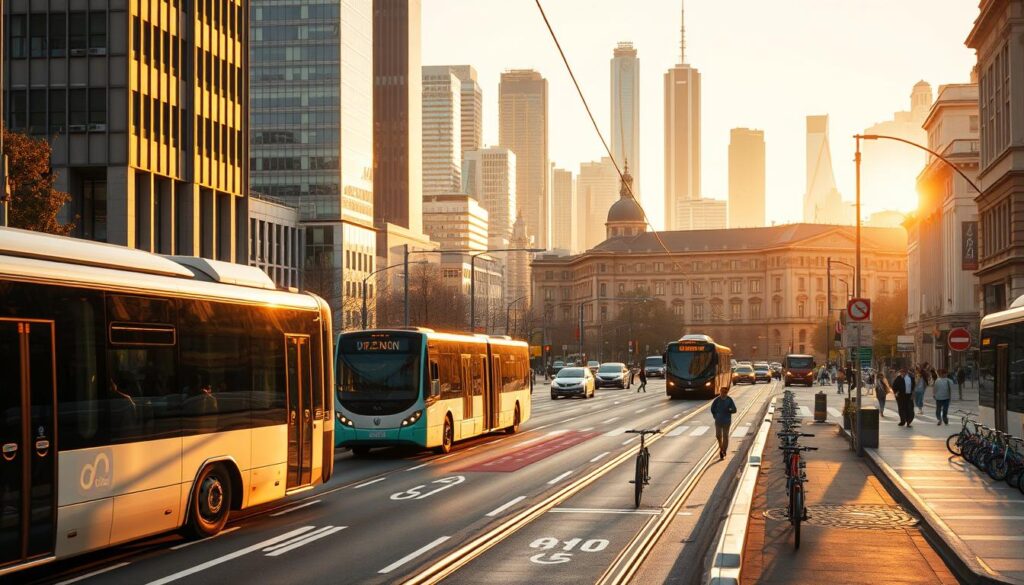Can a city’s mobility be enhanced without overhauling its entire public transport infrastructure? The answer lies in upgrading and optimizing the existing systems to create a more efficient and sustainable network.
The pandemic has left a lasting impact on city mobility, with many public transport systems still recovering. However, a robust transport infrastructure is crucial for vibrant cities and communities, facilitating the daily commute and contributing to sustainable transportation goals.
Upgrading public transport can significantly enhance the quality of life for citizens, making cities more livable and environmentally friendly.
Key Takeaways
- Upgrading public transport is crucial for enhancing city mobility.
- A robust transport system contributes to sustainable transportation goals.
- Efficient public transport infrastructure is key to vibrant cities.
- The pandemic has highlighted the need for resilient transport systems.
- Sustainable transportation options improve the quality of life for citizens.
The Importance of Public Transport Infrastructure
The significance of public transport infrastructure cannot be overstated, as it impacts various aspects of urban living. A well-developed transportation system is crucial for the efficient movement of people, goods, and services.
As cities continue to grow, the need for a reliable and efficient urban transit network becomes increasingly important. According to recent data, public transport provides a myriad of benefits that can help countries reach climate and development goals. There’s no better solution to moving large numbers of people efficiently, cheaply, and sustainably.
Economic Benefits of Enhanced Mobility
Enhanced mobility through improved public transport infrastructure has significant economic benefits. It boosts local economies by providing access to employment opportunities, education, and healthcare. A study on transportation network engineering highlights the importance of a well-planned transportation system in stimulating economic growth.
“Investing in public transport is one of the most effective ways to boost economic growth, reduce congestion, and improve air quality,” says a recent report on sustainable urban development.
Environmental Impact of Improved Public Transport
The environmental benefits of a well-developed metro infrastructure are substantial. By reducing the reliance on personal vehicles, public transport can significantly decrease carbon emissions and help mitigate climate change. Moreover, efficient public transport systems can reduce congestion, leading to lower emissions and improved air quality.
- Reduced carbon footprint
- Lower emissions
- Improved air quality
Social Equity and Accessibility
Public transport infrastructure also plays a critical role in promoting social equity and accessibility. By providing affordable and reliable transportation options, it ensures that all members of society have access to essential services and opportunities. This is particularly important for vulnerable populations, such as the elderly and those with disabilities.
In conclusion, the importance of public transport infrastructure cannot be overstated. It is a critical component of urban development, offering numerous economic, environmental, and social benefits. As cities continue to evolve, investing in a sustainable and efficient transportation system will be key to creating a better future for urban residents.
Current State of Public Transport in the U.S.
Public transportation in the U.S. is at a crossroads, with cities like New York and San Francisco showcasing exemplary bus rapid transit systems. Despite the challenges posed by the pandemic, many cities are innovating to regain ridership and improve their mass transit development.
Leading Cities in Public Transport
Cities across the U.S. are making significant strides in public transport. For instance, cities like Seattle and Denver have invested heavily in expanding their public transport networks, enhancing connectivity and reducing congestion.
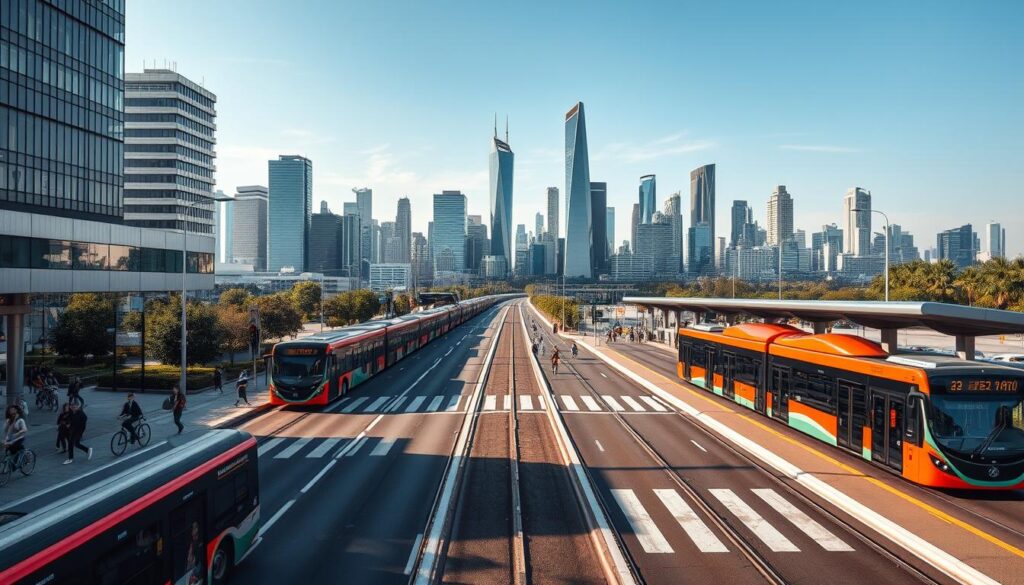
Challenges Facing Public Transport Systems
Despite these advancements, public transport systems face numerous challenges, including aging infrastructure and funding constraints. A quote from a transportation expert highlights the issue: “The biggest challenge is maintaining and upgrading our aging infrastructure without significant federal funding.” –
“The biggest challenge is maintaining and upgrading our aging infrastructure without significant federal funding.”
Recent Developments and Innovations
Innovations such as real-time tracking and smart ticketing solutions are being adopted by cities to enhance the passenger experience. A comparison of different cities’ approaches to mass transit development is shown in the table below.
| City | Public Transport Mode | Innovation |
|---|---|---|
| New York | Subway | Smart Ticketing |
| San Francisco | Bus Rapid Transit | Real-Time Tracking |
| Seattle | Light Rail | Integrated Transport Network |
These developments underscore the dynamic nature of public transport in the U.S., with cities continually seeking to improve their systems through mass transit development and innovative technologies.
Key Features of Effective Public Transport
The success of a city’s public transport system depends on several key features that work together seamlessly. Effective public transport is characterized by its ability to provide residents with reliable and convenient travel options.
Reliability and Frequency of Service
One of the primary factors that determine the effectiveness of a public transport system is its reliability and frequency of service. Residents need to be able to depend on the system to get them where they need to go on time. For instance, a study on effective public transit systems highlights the importance of maintaining a consistent schedule and frequency to keep the system running smoothly.
Frequent service is particularly important during peak hours to accommodate the high demand. This not only reduces congestion but also makes the system more appealing to potential users. By investing in sustainable transportation methods, cities can further enhance the reliability of their public transport.
Affordability for All Residents
Affordability is another critical aspect of an effective public transport system. The cost of using public transport should be reasonable and accessible to all residents, regardless of their income level. Cities can achieve this by implementing fare structures that are equitable and offering discounts for frequent users or vulnerable populations.
Moreover, integrating various payment methods can make the system more user-friendly. For example, smart ticketing solutions can simplify the process of traveling across different modes of transport, making it more convenient and affordable for residents.
Integration with Other Transportation Options
Seamless integration with other transportation options is vital for creating a comprehensive and efficient public transport network. This includes not only different modes of public transport but also private transportation services and infrastructure for cyclists and pedestrians.
By promoting multimodal transportation, cities can reduce reliance on personal vehicles, decrease congestion, and enhance overall city mobility. Effective integration requires careful planning and coordination among various stakeholders to ensure a smooth and efficient travel experience for residents.
Sustainable Public Transport Solutions
Sustainable public transport is no longer a luxury, but a necessity for modern cities aiming to reduce their environmental footprint. As urban populations continue to grow, the demand for efficient, eco-friendly transportation systems is becoming increasingly pressing.

Green Technologies in Public Transport
The integration of green technologies into public transport is revolutionizing the way cities move people around. From hybrid buses to hydrogen fuel cell vehicles, the options are expanding. For instance, cities are adopting sustainable mobility solutions that not only reduce emissions but also improve air quality.
The Role of Electric Buses
Electric buses are at the forefront of this green revolution. With data indicating that electric buses emit less than half as much carbon as fossil fuel-burning private cars per passenger per kilometer traveled, their adoption is a significant step towards a more sustainable urban transit network. Cities worldwide are transitioning their fleets to electric, benefiting from reduced operational costs and lower environmental impact.
Promoting Active Transportation
Beyond vehicular transport, promoting active transportation methods such as cycling and walking is crucial. Cities can achieve this by investing in dedicated bike lanes and pedestrian-friendly infrastructure. For more insights on the latest trends in green infrastructure, visit green infrastructure trends. Implementing bus rapid transit (BRT) systems can also encourage the use of public transport over personal vehicles, further reducing the carbon footprint of the transportation system.
Funding Sources for Upgrading Infrastructure
City mobility can be significantly improved by upgrading public transport, but where does the funding come from? Enhancing metro infrastructure and mass transit development requires substantial investment, but the benefits are multifaceted, including reduced congestion and improved air quality.
Expanding public transport can lower the total cost of urban mobility by $5.3 trillion per year by 2050, making it a worthwhile investment. Various funding sources can support this endeavor.
Federal and State Grants
One of the primary funding sources for mass transit development is federal and state grants. These grants are specifically designed to support transportation projects that enhance city mobility and reduce congestion.
Key Programs:
- FTA’s (Federal Transit Administration) Grants: Provides funding for transit projects.
- State-specific Grants: Many states have their own grant programs for transportation infrastructure.
Public-Private Partnerships
Public-private partnerships (PPPs) have emerged as a viable funding model for metro infrastructure projects. PPPs allow for the sharing of risks and rewards between the public and private sectors, facilitating complex infrastructure projects.
Benefits of PPPs:
- Bringing in private sector efficiency and innovation.
- Reducing the financial burden on the public sector.
- Accelerating project delivery.
Community Funding Initiatives
Community funding initiatives, such as local option taxes or bond measures, are another crucial funding source. These initiatives allow communities to directly support mass transit development and other transportation projects.
Examples:
| City | Funding Initiative | Project |
|---|---|---|
| Seattle | Sales tax increase | Light rail expansion |
| Denver | Fare increase and sales tax | Bus rapid transit system |
| Los Angeles | Measure M | Multi-modal transportation improvements |
By leveraging these funding sources, cities can make significant strides in enhancing their public transport systems, ultimately improving city mobility and the quality of life for their residents.
The Role of Technology in Public Transport
As cities evolve, the role of technology in public transport is becoming increasingly significant. The integration of advanced technologies is transforming public transportation systems, making them more efficient, reliable, and user-friendly.
Smart Ticketing Solutions
One of the key technological advancements in public transport is the implementation of smart ticketing solutions. These systems allow commuters to travel seamlessly across different modes of transport using a single ticket or card. For instance, contactless payment systems have simplified the process of buying tickets, reducing wait times, and enhancing the overall travel experience.
Smart ticketing also provides valuable data on passenger travel patterns, helping transport authorities to optimize their services. According to a report by Telefonica, the use of new technologies in public transport can significantly improve the efficiency of transportation systems.
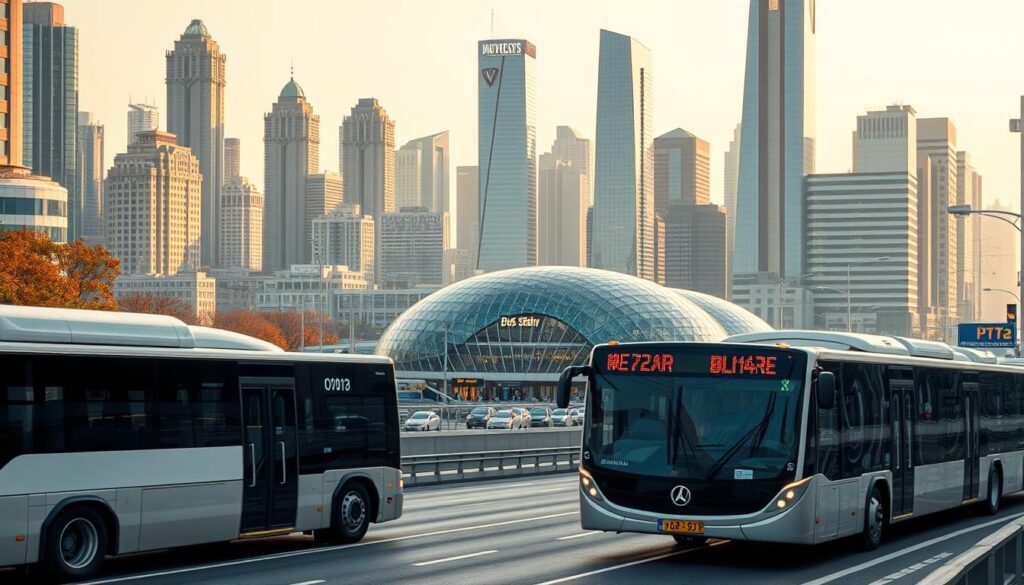
Real-Time Tracking and Updates
Another significant technological advancement is the introduction of real-time tracking and updates. This feature enables passengers to plan their journeys more effectively by providing them with accurate and up-to-date information about bus or train arrival times. Real-time tracking reduces waiting times and makes the travel experience more predictable and reliable.
Moreover, real-time data can be used by transport operators to monitor and manage their fleets more effectively, reducing delays and improving service reliability.
Data-Driven Decision Making
The use of data analytics in public transport is revolutionizing the way transport systems are planned and managed. By analyzing data on passenger numbers, travel patterns, and service performance, transport authorities can make informed decisions to improve their services. Data-driven decision making enables the optimization of routes, scheduling, and capacity, leading to more efficient and sustainable transportation systems.
Furthermore, data analytics can help in identifying areas of improvement and measuring the impact of changes made to the transport system, ensuring continuous improvement.
Engaging Communities in Public Transport Planning
Public transport planning is most effective when it involves the input of the community, reflecting their needs and preferences. Engaging with the community is crucial for developing an urban transit network that is both efficient and inclusive.
Importance of Public Input
Public input is vital as it provides insights into the needs and expectations of the community. It helps in identifying the areas that require improvement and the features that are appreciated by the users. This feedback is essential for creating a city mobility plan that is tailored to the needs of the residents.
- Understanding community needs and preferences
- Identifying areas for improvement
- Gathering support for public transport initiatives
Workshops and Community Meetings
Organizing workshops and community meetings is an effective way to engage with the public. These forums provide an opportunity for residents to share their views and suggestions on the bus rapid transit system and other public transport initiatives.
Collaborating with Local Organizations
Collaborating with local organizations is another strategy for effective community engagement. These organizations often have a deep understanding of the community’s needs and can facilitate communication between the public transport planners and the residents.
- Partnering with community groups to gather feedback
- Working with local businesses to understand their transport needs
- Engaging with advocacy groups to promote inclusive transport planning
By engaging communities in public transport planning, cities can develop transport systems that are more responsive to the needs of their residents, enhancing overall city mobility and quality of life.
Reducing Congestion Through Public Transport
By investing in public transport, cities can significantly reduce the number of cars on the road, thereby decreasing congestion. A well-developed transportation system not only alleviates traffic jams but also contributes to a cleaner environment and improved quality of life for residents.
Benefits of Fewer Cars on the Road
Reducing the number of cars on the road has numerous benefits, including decreased air pollution and lower traffic congestion. With fewer vehicles, the overall emission of harmful pollutants is significantly reduced, leading to a healthier environment. Moreover, less congested roads result in shorter commute times, enhancing productivity and overall quality of life.
Efficient mass transit development is crucial in achieving these benefits. By providing reliable and convenient public transport options, cities can encourage more people to use these services instead of driving personal vehicles.
Case Studies of Successful Congestion Reduction
Several cities around the world have successfully implemented strategies to reduce traffic congestion through enhanced public transport. For instance, cities like Singapore and London have introduced congestion pricing schemes, which charge drivers a fee to enter certain areas during peak hours, thereby discouraging the use of personal vehicles.
Another example is Curitiba, Brazil, which has developed an efficient bus rapid transit (BRT) system. This system has significantly reduced the reliance on personal vehicles, resulting in less congested roads and a more sustainable urban environment.
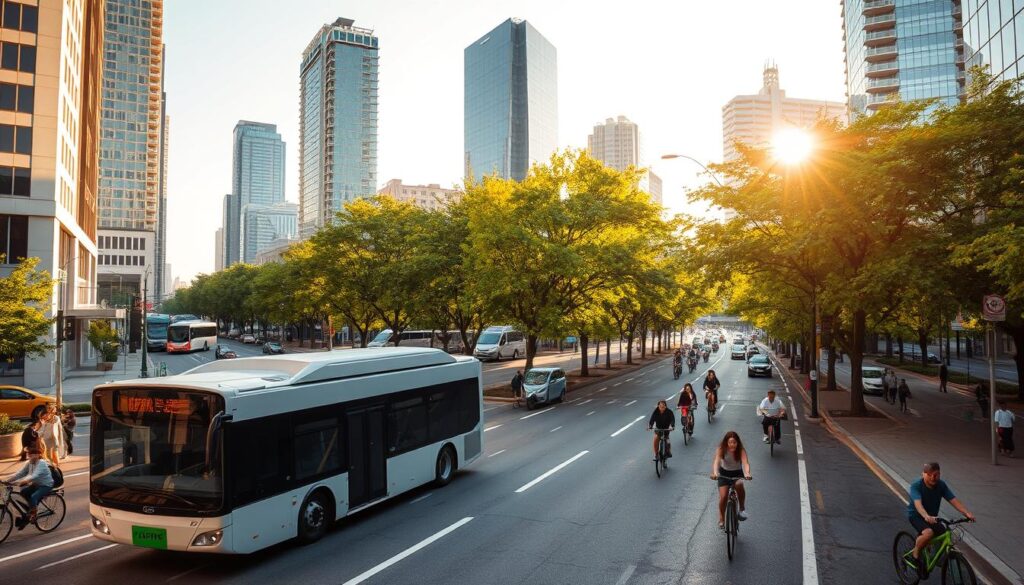
Long-Term Urban Planning Strategies
To achieve long-term reductions in traffic congestion, cities must adopt comprehensive urban planning strategies that prioritize sustainable transportation. This includes investing in modern public transport infrastructure, promoting mixed-use development, and enhancing pedestrian and cycling infrastructure.
A key aspect of long-term planning is the integration of different transport modes. By creating seamless connections between buses, trains, and other forms of public transport, cities can provide residents with convenient and efficient travel options, further discouraging the use of personal vehicles.
| City | Strategy Implemented | Outcome |
|---|---|---|
| Singapore | Congestion Pricing | Reduced traffic congestion by 15% |
| London | Congestion Charge | Decreased vehicle traffic by 20% |
| Curitiba | Bus Rapid Transit (BRT) System | Significantly reduced reliance on personal vehicles |
Future Trends in Public Transport Infrastructure
As cities continue to evolve, the future of public transport infrastructure is being shaped by innovative technologies and changing urban landscapes. The way people move around cities is undergoing a significant transformation, driven by the need for more efficient, sustainable, and integrated transportation systems.
Autonomous Vehicles and Their Potential
One of the most significant trends shaping the future of public transport is the advent of autonomous vehicles. These vehicles have the potential to revolutionize public transport by improving safety, reducing labor costs, and enhancing the passenger experience. Autonomous buses and shuttles are being tested in various cities around the world, with promising results.
The integration of autonomous vehicles into public transport systems could lead to more efficient service, as vehicles can operate around the clock without the need for driver breaks. Moreover, autonomous technology can optimize routes in real-time, reducing congestion and lowering emissions.
The Move Toward Multimodal Transportation
Another key trend is the move toward multimodal transportation, where different modes of transport are integrated to provide seamless journeys. This includes combining bus, train, bike, and ride-sharing services into a single, user-friendly network. Multimodal transportation enhances the flexibility and convenience of public transport, making it more appealing to a wider audience.
By providing passengers with real-time information and easy payment options across different modes of transport, cities can encourage more people to use public transport, reducing reliance on personal vehicles and decreasing congestion.
Trends in Urban Development and Planning
Urban development trends are also playing a crucial role in shaping public transport infrastructure. As cities grow and densify, there is a greater need for efficient and sustainable transport solutions. Transit-Oriented Development (TOD) is becoming increasingly popular, where urban planning is focused around public transport hubs, promoting mixed-use development and reducing the need for lengthy commutes.
Furthermore, the trend towards sustainable urban planning is driving the adoption of green technologies and infrastructure in public transport. This includes the use of electric buses, green roofs on transport facilities, and energy-efficient lighting, all contributing to a more sustainable urban environment.
Enhancing Safety and Security
A well-designed public transport system prioritizes the safety and security of its passengers. This not only enhances the user experience but also encourages more people to use public transport, thereby contributing to a more sustainable transportation network.
One of the critical aspects of safety and security in public transport is the implementation of effective crime prevention strategies. This can include the use of CCTV cameras, improved lighting, and increased security personnel, particularly during peak hours. For instance, a study on urban transit networks highlighted the importance of such measures in reducing crime rates.
Crime Prevention Strategies
Crime prevention is a multifaceted approach that involves both the design of the transport infrastructure and the implementation of security protocols. For example, bus rapid transit systems can be designed with safety features such as off-street stations and secure payment systems. Moreover, community engagement and awareness programs can play a significant role in preventing crime.
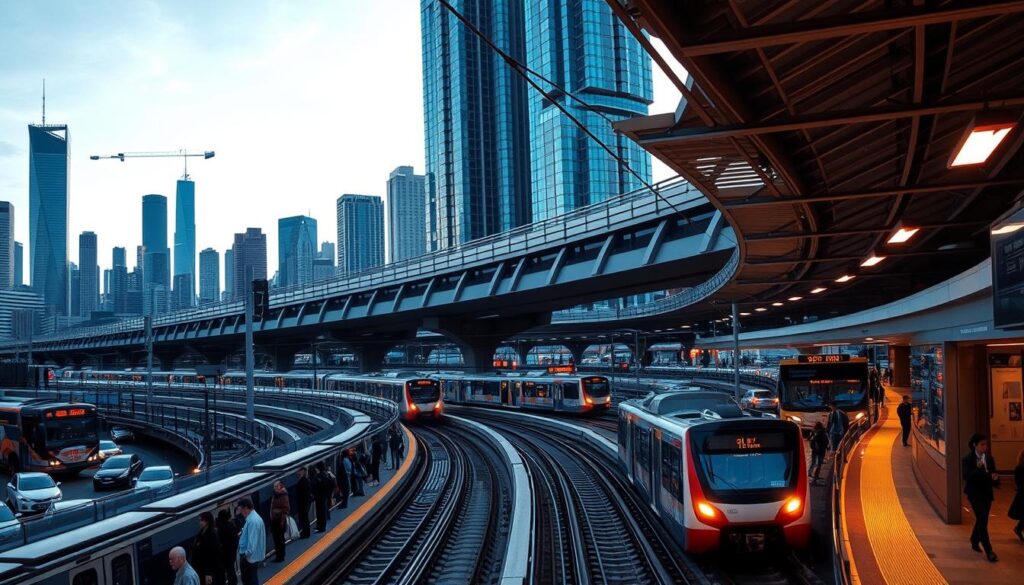
Impact of Well-Designed Infrastructure
The design of public transport infrastructure has a significant impact on safety and security. Well-lit and well-maintained stations, clear signage, and accessible emergency facilities all contribute to a safer environment for passengers. Furthermore, the integration of technology, such as real-time tracking and smart surveillance systems, can enhance the overall security of the urban transit network.
Educating the Public on Safety Measures
Educating passengers on safety measures is another crucial aspect of enhancing safety and security. Public awareness campaigns can inform users about the importance of being vigilant and reporting suspicious activities. Additionally, training programs for transport staff can ensure that they are equipped to handle emergencies effectively.
In conclusion, enhancing safety and security in public transport requires a comprehensive approach that includes crime prevention strategies, well-designed infrastructure, and public education campaigns. By prioritizing these aspects, cities can develop a more secure and reliable bus rapid transit system, ultimately contributing to a more sustainable and livable urban environment.
The Global Perspective on Public Transport
As urbanization continues to rise, cities around the world are implementing cutting-edge public transport solutions. This global movement towards enhanced mobility is driven by the need for sustainable, efficient, and accessible transportation systems.
Lessons from European Cities
European cities have long been at the forefront of public transport innovation. Cities like London and Paris have invested heavily in comprehensive public transport networks, including buses, trains, and subways. These cities have demonstrated the importance of integrating different modes of transport to create seamless travel experiences. For instance, London’s Transport for London system is renowned for its efficiency and coverage.
Moreover, European cities are pioneers in adopting green technologies in public transport. The use of electric buses and trams is becoming increasingly common, reducing emissions and improving air quality. Cities like Copenhagen aim to be carbon neutral, with public transport playing a crucial role in achieving this goal.
Innovations in Asia’s Public Transport
Asian cities are also making significant strides in public transport development. Singapore is a prime example, with its highly efficient and technologically advanced public transport system. The city-state’s Mass Rapid Transit (MRT) system is one of the most extensive in the world, providing reliable and convenient travel options for its residents.
Other Asian cities, like Tokyo and Seoul, are known for their punctuality and advanced technology in public transport. Tokyo’s train network is famous for its precision, with delays being extremely rare. Seoul, on the other hand, has implemented a comprehensive bus rapid transit (BRT) system, enhancing mobility within the city.
Comparison with Other Developed Nations
When comparing public transport systems globally, it’s clear that different regions have their unique strengths. For example, cities in developed nations like the United States, Canada, and Australia are focusing on modernizing their infrastructure and adopting new technologies.
In the United States, cities like New York and San Francisco are investing in upgrading their public transport systems. New York’s subway system, one of the largest in the world, is undergoing significant upgrades to improve reliability and efficiency. San Francisco’s BART system is expanding, enhancing connectivity within the Bay Area.
The global perspective on public transport highlights the diverse approaches cities are taking to enhance mobility. By learning from these international examples, cities can develop more effective and sustainable public transport systems.
Policy Changes Needed for Improvement
Advocating for comprehensive transportation policies is essential to create a more efficient and sustainable urban transit network. Effective public transport requires a multifaceted approach that includes not just infrastructure development but also supportive policies and streamlined bureaucratic processes.
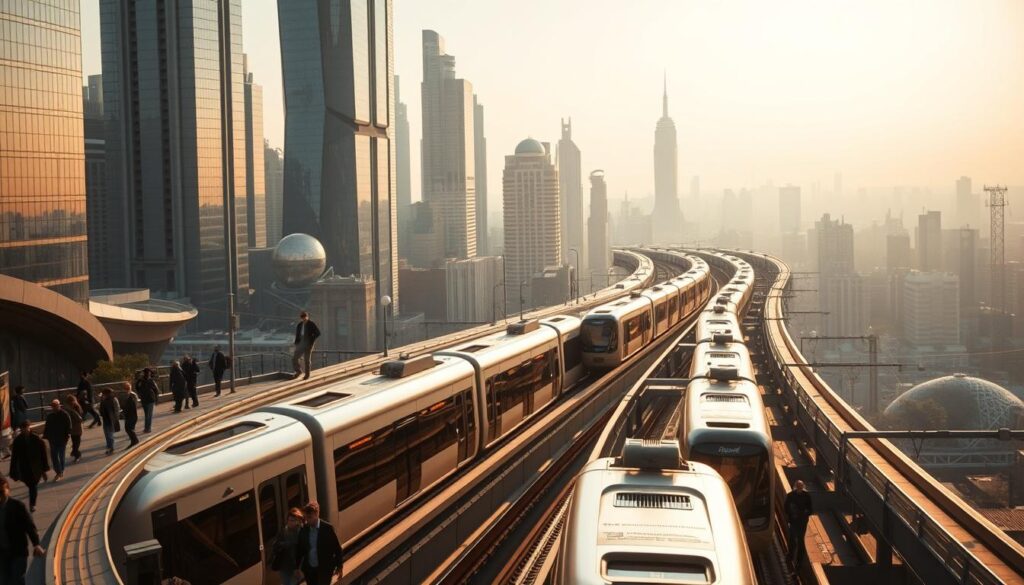
Comprehensive Transportation Policies
Comprehensive transportation policies are vital for enhancing city mobility. These policies should aim at integrating different modes of transport, promoting sustainable transportation options, and ensuring that the urban transit network is accessible to all residents. According to a study published on PMC, integrated transportation systems can significantly improve the efficiency and appeal of public transport.
Key elements of comprehensive transportation policies include:
- Investing in green technologies to reduce environmental impact
- Promoting active transportation through infrastructure like bike lanes and pedestrian paths
- Ensuring affordability and accessibility for all residents
The Role of Government in Supporting Public Transport
The government plays a crucial role in supporting public transport through funding, legislation, and oversight. By providing financial incentives and developing policies that encourage the use of public transport, governments can significantly enhance the quality and reach of urban transit networks.
“Government support is critical for the development of sustainable transportation systems. Policies that promote public transport can lead to reduced congestion, lower emissions, and improved quality of life.” – Expert in Urban Planning
Reducing Bureaucratic Barriers
Reducing bureaucratic barriers is essential for the timely implementation of public transport projects. Streamlining approval processes and minimizing regulatory hurdles can help in delivering projects more efficiently.
Some strategies for reducing bureaucratic barriers include:
- Simplifying the approval process for transport projects
- Enhancing collaboration between different government agencies
- Implementing transparent and accountable project management practices
By advocating for comprehensive transportation policies, supporting public transport through government initiatives, and reducing bureaucratic barriers, cities can significantly improve their urban transit networks, enhancing city mobility and promoting sustainable transportation.
Best Practices in Public Transport Management
The success of public transport systems depends on adopting best practices in management. Effective management involves a combination of strategic planning, technology integration, and continuous improvement.
Learning from Successful Case Studies
One of the best ways to improve public transport management is by learning from successful case studies. Cities with well-developed metro infrastructure and bus rapid transit systems offer valuable insights. For instance, cities like Curitiba in Brazil and Vancouver in Canada have implemented innovative public transport solutions that have significantly enhanced mobility.
- Curitiba’s Bus Rapid Transit (BRT) system is renowned for its efficiency and has been a model for other cities.
- Vancouver’s SkyTrain is a fully automated, driverless system that has set a high standard for reliability and safety.
Key Performance Indicators to Monitor Success
To ensure the effectiveness of public transport management, it’s crucial to monitor key performance indicators (KPIs). These may include:
- Ridership numbers
- On-time performance
- Customer satisfaction
- Operational costs
By tracking these KPIs, transport authorities can identify areas for improvement and make data-driven decisions to enhance mass transit development.
Continuous Improvement Strategies
Continuous improvement is vital for maintaining a competitive and efficient public transport system. Strategies may include:
- Regularly updating infrastructure to incorporate new technologies
- Engaging with the community to understand their needs and preferences
- Implementing flexible routing and scheduling to adapt to changing demand
By adopting these strategies, cities can ensure their public transport systems remain effective and responsive to the needs of their residents.
Building Accessible Public Transport for All
Accessible public transport is not just a convenience, it’s a necessity for fostering equitable city mobility. Ensuring that everyone, regardless of age or ability, can use public transport is crucial for creating a sustainable and inclusive community.
ADA Compliance and Beyond
The Americans with Disabilities Act (ADA) sets a baseline for accessibility in public transport. However, simply meeting these standards is not enough. Transportation systems should strive to go beyond mere compliance and create an environment that is welcoming and usable for all. This includes incorporating features such as audio announcements, tactile signage, and wheelchair-accessible vehicles.
For more detailed information on accessibility guidelines, refer to resources such as this document from the International Transport Forum.
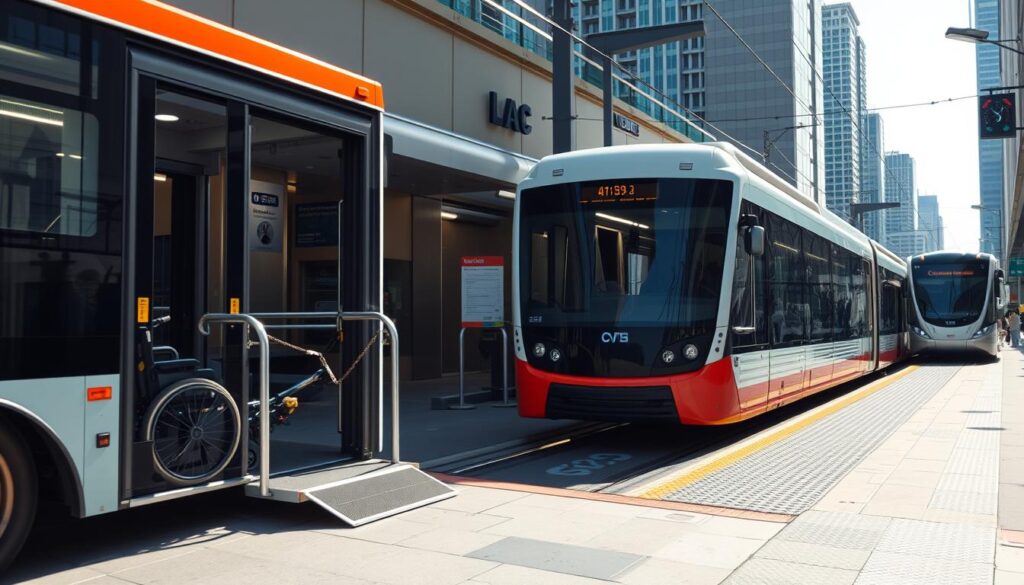
Meeting the Needs of Vulnerable Populations
Vulnerable populations, including the elderly, children, and those with disabilities, have unique needs that must be addressed in public transport planning. Transportation infrastructure should be designed to be safe, reliable, and easy to navigate for these groups. This can involve implementing measures such as priority seating, clear signage, and real-time information systems.
Advocacy for Inclusive Design
Advocating for inclusive design in public transport infrastructure is essential for creating a city that is truly accessible to all. This involves engaging with the community, understanding their needs, and incorporating their feedback into the design process. By doing so, cities can create public transport systems that are not only functional but also equitable and sustainable.
By focusing on accessibility and inclusivity, cities can enhance their public transport infrastructure, improve city mobility, and promote sustainable transportation solutions.
Tips for Residents to Engage with Local Transport Systems
Residents have the power to shape their transportation system by getting involved in local planning discussions. Engaging with your local transport system is a crucial step towards creating a more efficient and user-friendly urban transit network.
Getting Involved in Planning Discussions
One of the most effective ways to engage with your local transport system is by participating in planning discussions. Attend community meetings and join local transportation committees to have your voice heard. For instance, you can learn more about initiatives that promote walking, cycling, and public transport by visiting SLoCaT’s website.
- Stay informed about upcoming public meetings.
- Prepare your thoughts and suggestions in advance.
- Engage with other community members to build a stronger, more unified voice.
Utilizing Feedback Channels Effectively
Providing feedback is a vital component of improving your local bus rapid transit and overall transportation system. Use the available feedback channels, such as online surveys, customer service hotlines, and mobile apps, to report issues and suggest improvements.
- Be specific and clear about the issue or suggestion.
- Provide supporting evidence or examples if possible.
- Follow up on your feedback to ensure it has been addressed.
Staying Informed About Developments
Staying up-to-date with the latest developments in your local transport system is essential. Follow local transportation authorities on social media, sign up for newsletters, and visit their websites regularly.
| Information Source | Description | Benefits |
|---|---|---|
| Social Media | Follow local transport authorities | Real-time updates and announcements |
| Newsletters | Subscribe to transport newsletters | Detailed updates on projects and initiatives |
| Official Websites | Visit transport authority websites | Comprehensive information on services and plans |
By following these tips, residents can play a significant role in shaping their local transport systems, contributing to a more efficient, sustainable, and user-friendly transportation system for everyone.
Conclusion: A Community Effort for Better Mobility
Enhancing public transport in U.S. cities requires a multifaceted approach that involves sustainable transportation solutions, effective mass transit development, and a focus on city mobility. By working together, residents, leaders, and policymakers can create a more efficient and accessible transportation system.
Collaborative Efforts
The future of public transport depends on collaboration. Residents must engage with local transport systems, provide feedback, and participate in planning discussions. Leaders and policymakers must prioritize sustainable transportation and invest in mass transit development to enhance city mobility.
Shaping the Future
As U.S. cities continue to evolve, the need for innovative and sustainable transportation solutions becomes increasingly important. By adopting green technologies, promoting active transportation, and leveraging technology, cities can reduce congestion and improve air quality.
Taking Action
Residents and leaders must work together to shape the future of public transport. This involves advocating for comprehensive transportation policies, supporting community funding initiatives, and promoting inclusive design. By doing so, cities can create a more equitable and efficient transportation system that benefits everyone.
